Here’s some photos from Bell Sunday – our celebration of our 50th anniversary of our bells from 10 to 12 and the dedication of our new carillon, electronic chiming device.
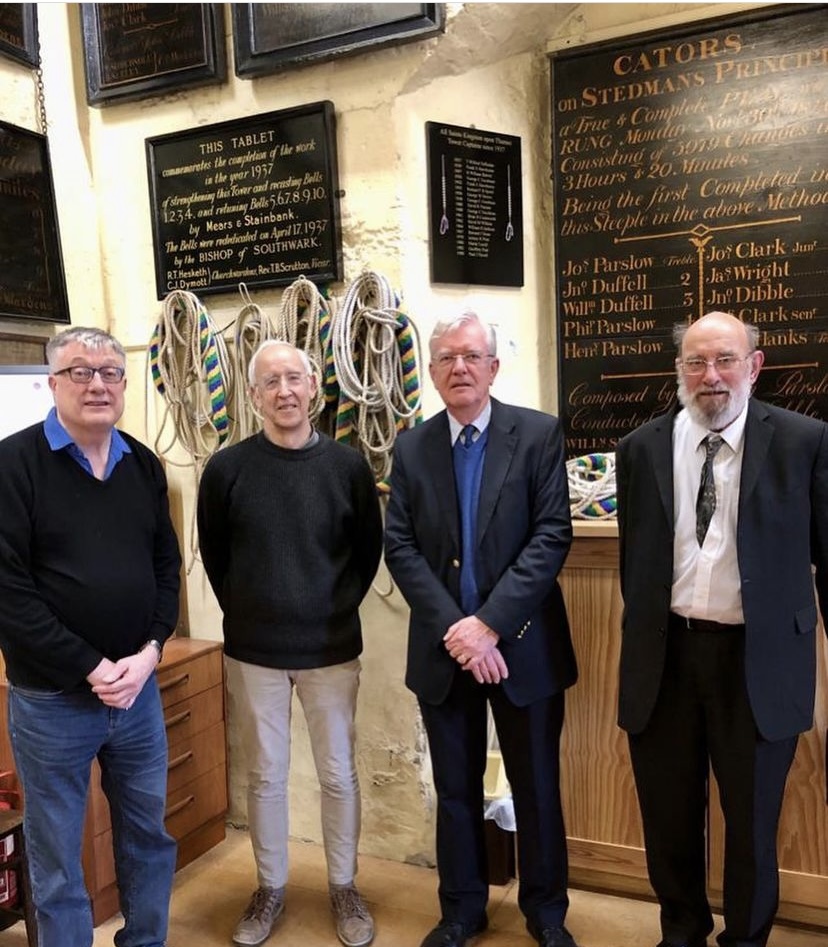
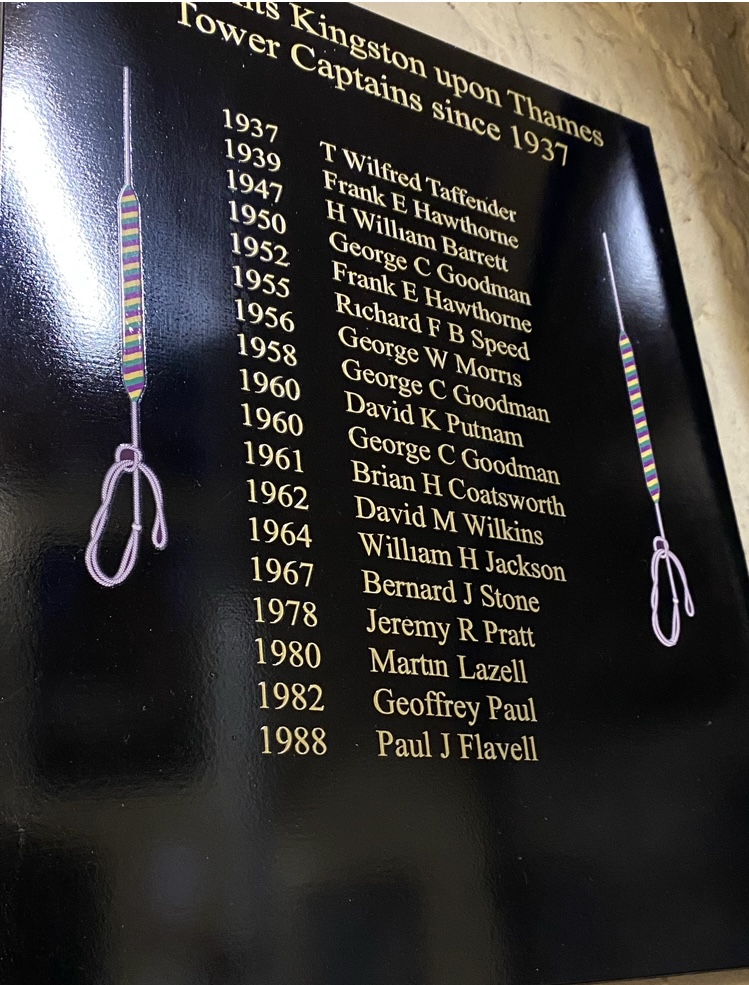
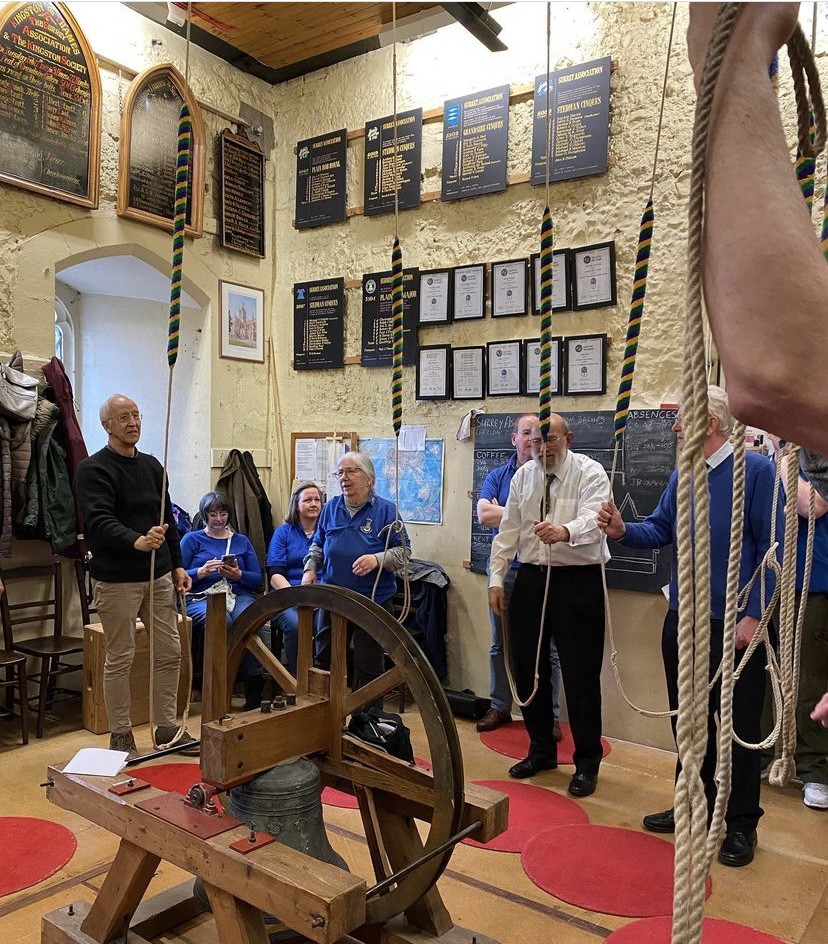
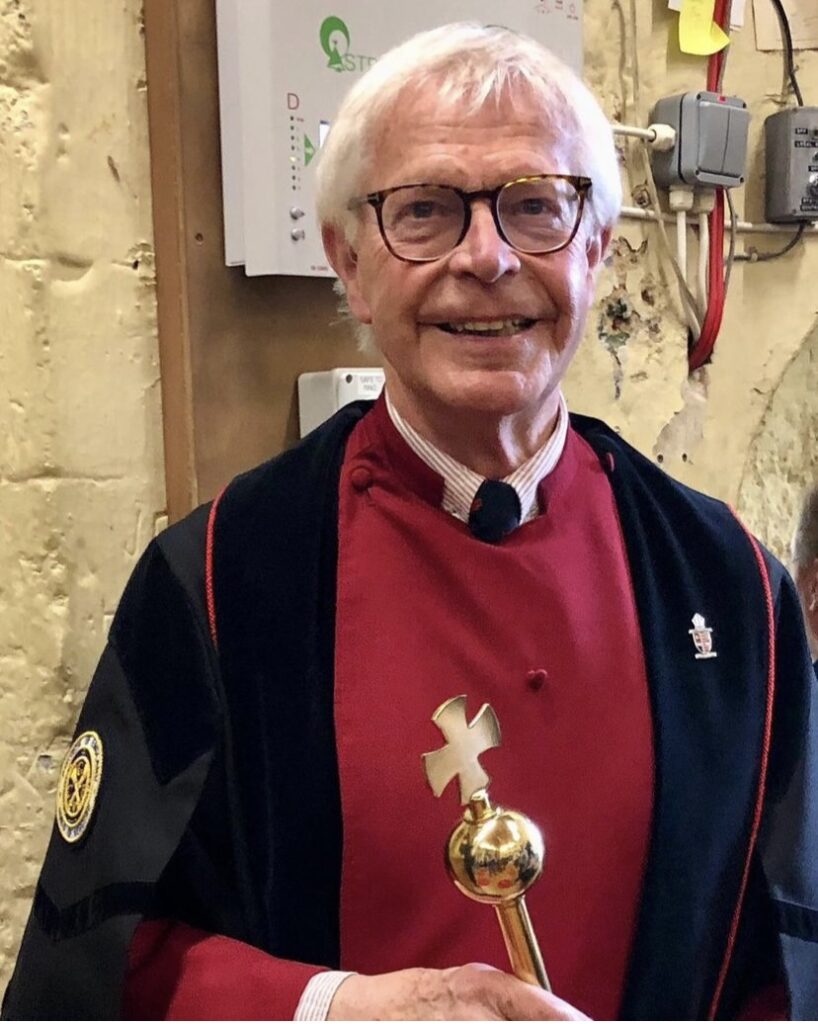
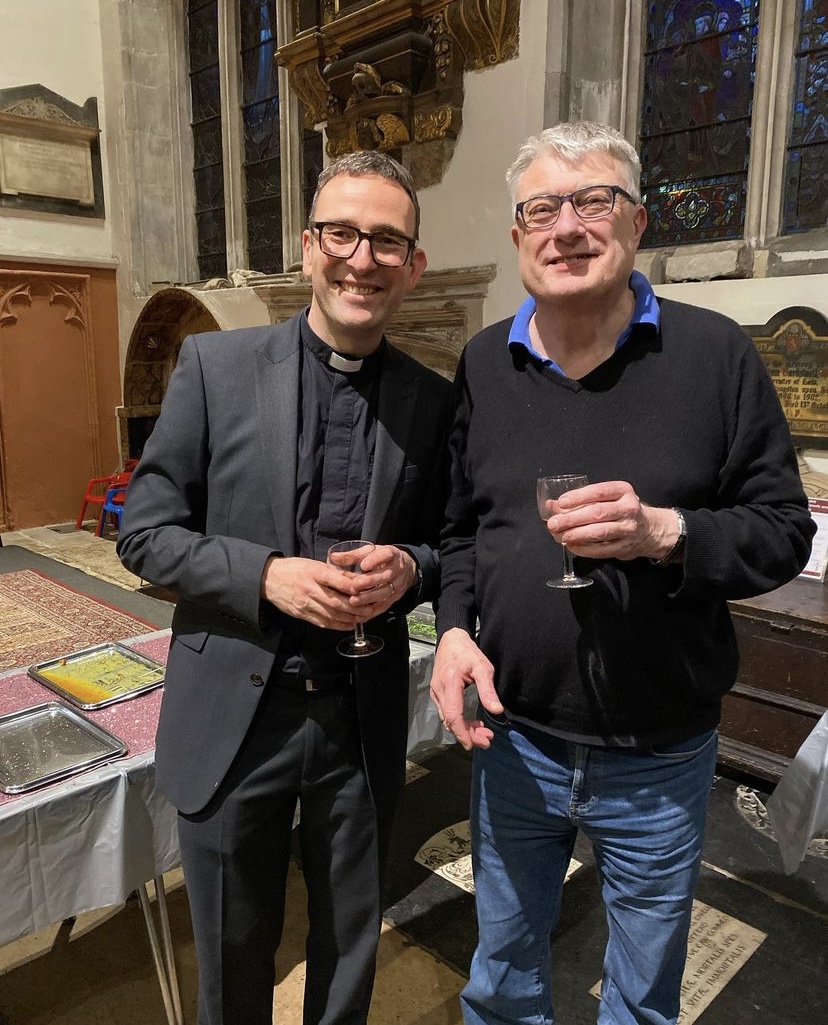
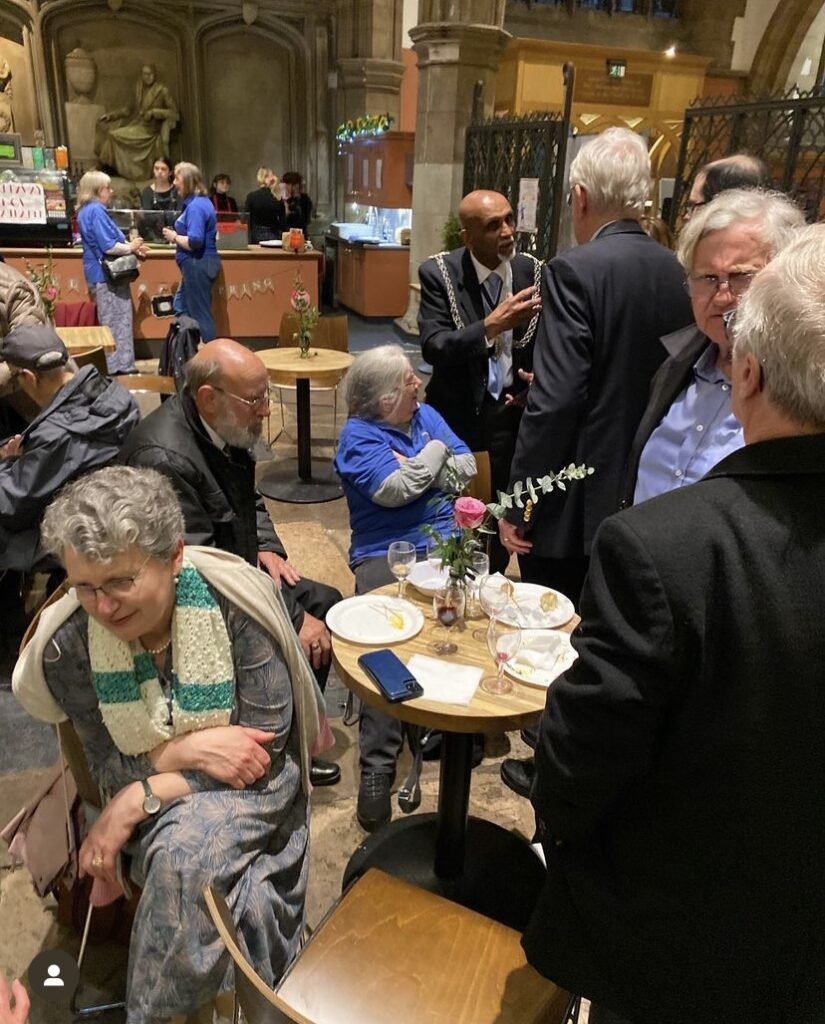
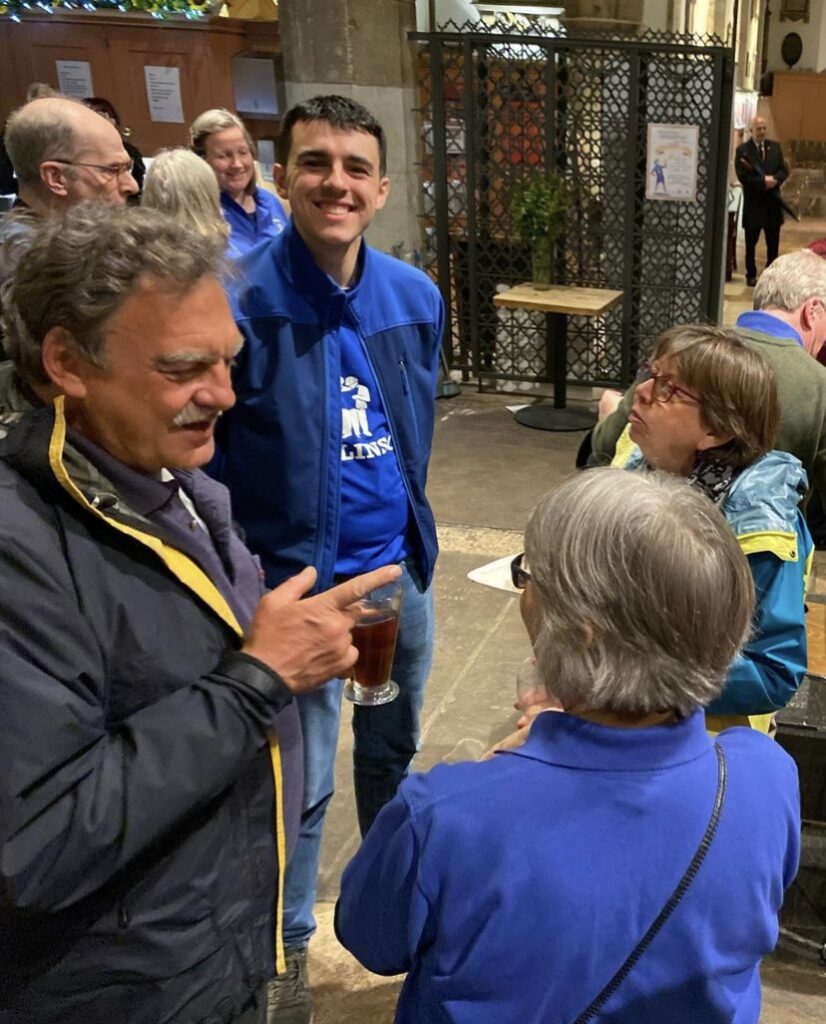
Here’s some photos from Bell Sunday – our celebration of our 50th anniversary of our bells from 10 to 12 and the dedication of our new carillon, electronic chiming device.







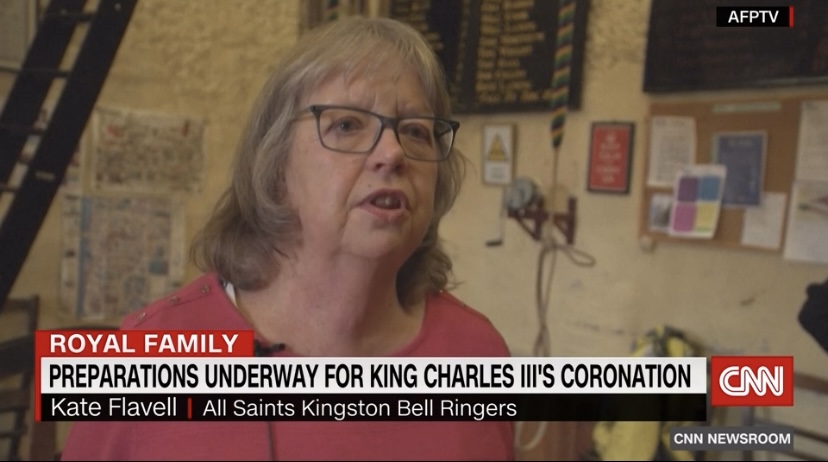
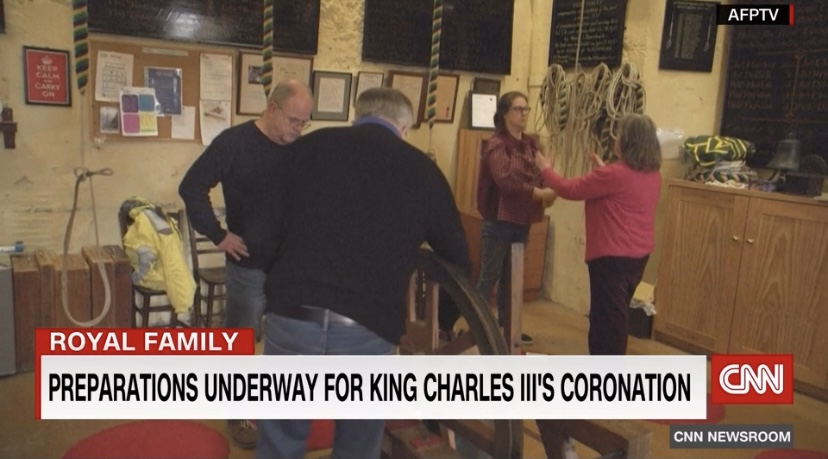
The camera crew who came to our tower have sold the video clips to media outlets around the world, including CNN! Here we are in this clip about how the UK is preparing to crown a new sovereign.
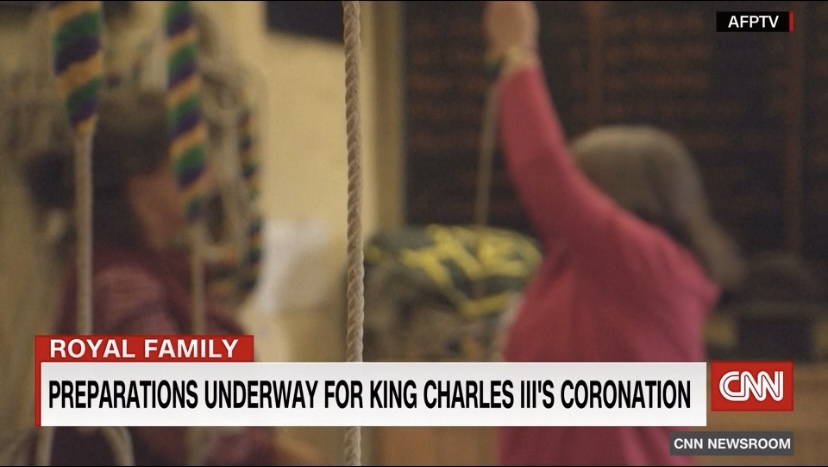
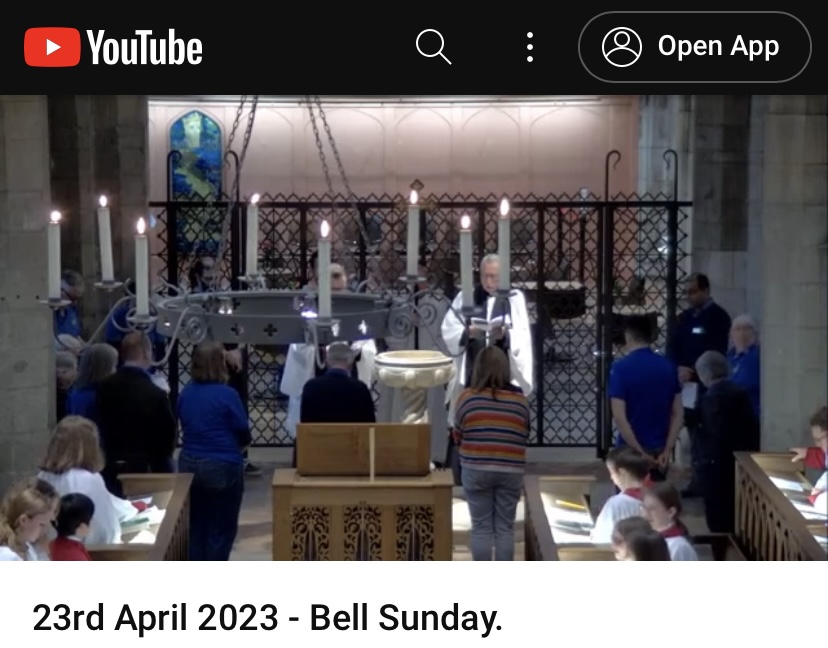
You can watch the service on the All Saints Church Youtube channel: https://m.youtube.com/watch?v=W69iY0SS_70
And the service booklet is here, with a page about the carillon and our bells, and the back page is about the ringers.
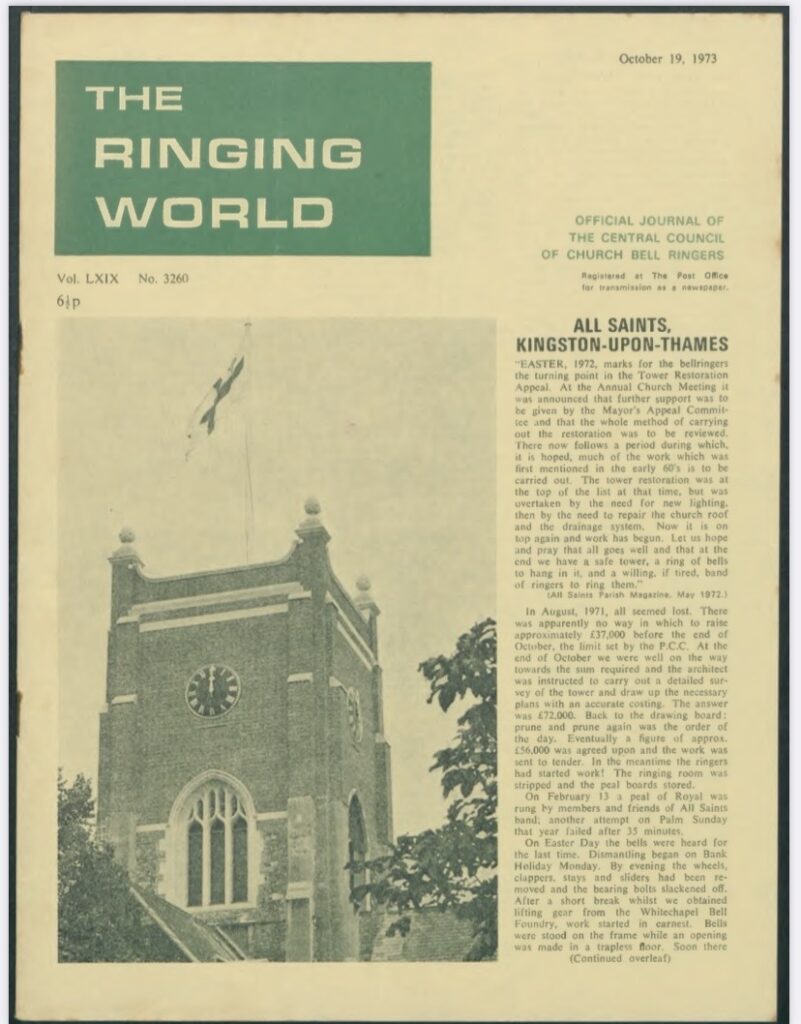
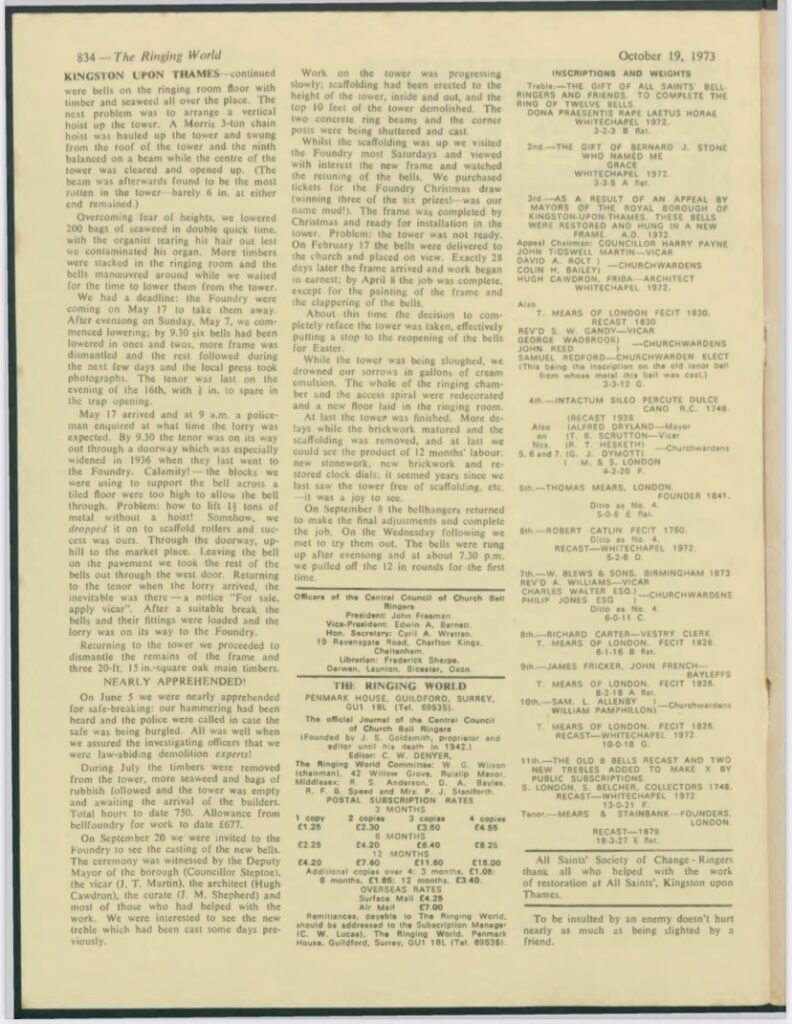
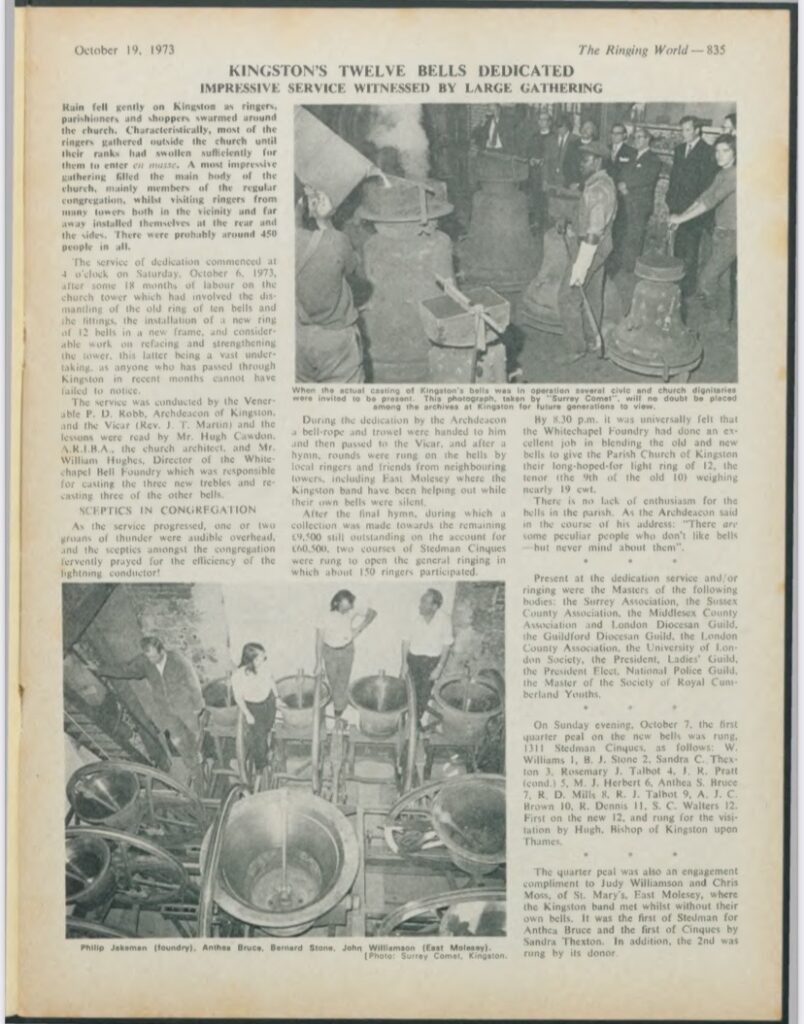
Text from article copied below:
The Ringing World, October 19, 1973
ALL SAINTS, KINGSTON-UPON-THAMES
“EASTER, 1972, marks for the bellringers the turning point in the Tower Restoration Appeal. At the Annual Church Meeting it was announced that further support was to be given by the Mayor’s Appeal Committee and that the whole method of carrying out the restoration was to be reviewed. There now follows a period during which, it is hoped, much of the work which was first mentioned in the early 60’s is to be carried out. The tower restoration was at the top of the list at that time, but was overtaken by the need for new lighting, then by the need to repair the church roof and the drainage system. Now it is on top again and work has begun. Let us hope and pray that all goes well and that at the end we have a safe tower, a ring of bells to hang in it, and a willing, if tired, band of ringers to ring them .”
(All Saints Parish Magazine, May 1972.)
In August, 1971, all seemed lost. There was apparently no way in which to raise approxim ately £37,000 before the end of October, the limit set by the P.C.C. At the end of October we were well on the way towards the sum required and the architect was instructed to carry out a detailed survey of the tower and draw up the necessary plans with an accurate costing. The answer was £72,000. Back to the drawing board: prune and prune again was the order of the day. Eventually a figure of approx. £56,000 was agreed upon and the work was sent to tender. In the meantime the ringers had started work! The ringing room was stripped and the peal boards stored.
On February 13 a peal of Royal was rung by members and friends of All Saints band; another attem pt on Palm Sunday that year failed after 35 minutes.
On Easter Day the bells were heard for the last time. Dismantling began on Bank Holiday Monday. By evening the wheels, clappers, stays and sliders had been re moved and the bearing bolts slackened off. After a short break whilst we obtained lifting gear from the Whitechapel Bell Foundry, work started in earnest. Bells were stood on the frame while an opening was made in a trapless floor. Soon there were bells on the ringing room floor with timber and seaweed all over the place. The next problem was to arrange a vertical hoist up the tower. A Morris 3-ton chain hoist was hauled up the tower and swung from the roof of the tower and the ninth balanced on a beam while the centre of the tower was cleared and opened up. (The beam was afterwards found to be rotten in the tower—barely 6 in. at either end remained.)
Overcoming fear of heights, we lowered 200 bags of seaweed in double quick time, with the organist tearing his hair out lest we contaminated his organ. More timbers were stacked in the ringing room and the bells manoeuvred around while we waited for the time to lower them from the tower.
We had a deadline: the Foundry were coming on May 17 to take them away. After evensong on Sunday, May 7, we commenced lowering; by 9.30 six bells had been lowered in ones and twos, more frame was dismantled and the rest followed during the next few days and the local press took photographs. The tenor was last on the evening of the 16th, within 3/8 to spare in the trap opening.
May 17 arrived and at 9 a.m. a policeman enquired at what time the lorry was expected. By 9.30 the tenor was on its way out through a doorway which was especially widened in 1936 when they last went to the Foundry. Calamity! — the blocks we were using to support the bell across a tiled floor were too high to allow the bell through. Problem: how to lift tons of metal without a hoist! Somehow, we dropped it on to scaffold rollers and success was ours. Through the doorway, uphill to the market place. Leaving the bell on the pavement we took the rest of the bells out through the west door. Returning to the tenor when the lorry arrived, the inevitable was there—a notice “For sale, apply vicar”. After a suitable break the bells and their fittings were loaded and the lorry was on its way to the Foundry.
Returning to the tower we proceeded to dismantle the remains of the frame and three 20-ft. 15in.-square oak main timbers.
NEARLY APPREHENDED!
On June 5 we were nearly apprehended for safe-breaking: our hammering had been heard and the police were called in case the safe was being burgled. All was well when we assured the investigating officers that we were law-abiding demolition experts’.
During July the timbers were removed from the tower, more seaweed and bags of rubbish followed and the tower was empty and awaiting the arrival of the builders. Total hours to date 750. Allowance from bell foundry for work to date £677.
On September 20 we were invited to the Foundry to see the casting of the new bells. The ceremony was witnessed by the Deputy Mayor of the borough (Councillor Steptoe), the vicar (J. T. Martin), the architect (Hugh Cawdron), the curate (J. M. Shepherd) and most of those who had helped with the work. We were interested to see the new treble which had been cast some days previously.
Work on the tower was progressing slowly; scaffolding had been erected to the height of the tower, inside and out, and the top 10 feet of the tower demolished. The two concrete ring beams and the corner posts were being shuttered and cast.
Whilst the scaffolding was up we visited the Foundry most Saturdays and viewed with interest the new frame and watched the retuning o f the bells. We purchased tickets for the Foundry Christmas draw (winning three of the six prizes!—was our name mud!). The frame was completed by
Christmas and ready for installation in the tower. Problem: the tower was not ready. On February 17 the bells were delivered to the church and placed on view. Exactly 28 days later the frame arrived and work began
in earnest; by April 8 the job was complete, except for the painting of the frame and the clappering of the bells.
About this time the decision to completely reface the tower was taken, effectively putting a stop to the reopening of the bells for Easter.
While the tower was being sloughed, we drowned our sorrows in gallons of cream emulsion. The whole of the ringing chamber and the access spiral were redecorated and a new floor laid in the ringing room.
At last the tower was finished. More delays while the brickwork matured and the scaffolding was removed, and at last we could see the product of 12 months’ labour: new stonework, new brickwork and restored clock dials; it seemed years since we last saw the tower free of scaffolding, etc.
—it was a joy to see.
On September 8 the bellhangers returned to make the final adjustments and complete the job. On the Wednesday following we met to try them out. The bells were rung up after evensong and at about 7.30 p.m.
we pulled off the 12 in rounds for the first time.
INSCRIPTIONS AND WEIGHTS
Treble.— THE GIFT OF ALL SAINTS’ BELLRINGERS AND FRIENDS. TO COMPLETE THE RING OF TWELVE BELLS.
DONA PRAESENTIS RAPE LAETUS HORAE
WHITECHAPEL 1972.
3-2-3 B flat.
2nd.— THE GIFT OF BERNARD J. STONE WHO NAMED ME
GRACE
WHITECHAPEL 1972.
3-3-5 A flat.
3rd.— AS A RESULT OF AN APPEAL BY MAYORS OF THE ROYAL BOROUGH OF KINGSTON-UPON-THAMES, THESE BELLS
WERE RESTORED AND HUNG IN A NEW FRAME. A.D. 1972.
Appeal Chairman: COUNCILLOR HARRY PAYNE
JOHN TIDSWELL MARTIN— VICAR
DAVID A. ROLT
COLIN H. BAILEY) — CHURCHWARDENS
HUGH CAWDRON, FRIBA— ARCHITECT
WHITECHAPEL 1972.
Also
T. MEARS OF LONDON FECIT 1830.
RECAST 1830
REV’D S. W. GANDY— VICAR
GEORGE WADBROOK, — CHURCHWARDENS
SAMUEL REDFORD— CHURCHWARDEN ELECT
(This being the inscription on the old tenor bell from whose metal this bell was cast.)
3-3-12 G.
4th,— INTACTUM SILEO PERCUTE DULCE CANO R.C. 1748.
(RECAST 1936
Also (ALFRED DRYLAND— Mayor
on (T. B. SCRUTTON— Vicar
Nos. (R. T HESKETH) — Churchwardens
5th.— THOMAS MEARS, LONDON.
FOUNDER 1841.
Ditto as No. 4.
5-0-6 E flat.
6th.— ROBERT CATLIN FECIT 1750.
Ditto as No. 4
RECAST— WHITECHAPEL 1972.
5-2-6 D.
7th.— W. BLEWS S SONS. BIRMINGHAM 1873
REV’D A. WILLIAMS— VICAR
CHARLES WALTERS ESQ.
PHILIP JONES ESQ. —CHURCHWARDENS
Ditto as No. 4.
6-0-11 C.
8th.— RICHARD CARTER— VESTRY CLERK.
T. MEARS OF LONDON. FECIT 1826.
6-1-16 B flat.
9th.— JAMES FRICKER, JOHN FRENCH—BAYLEFFS
T. MEARS OF LONDON. FECIT 1826.
8-2-16 A flat.
10th— SAM. L. ALLENBY
WILLIAM PAMPHILLON — Churchwardens
T. MEARS OF LONDON. FECIT 1826.
RECAST— WHITECHAPEL 1972.
10-0-18 G.
11th.— THE OLD 8 BELLS RECAST AND TWO NEW TREBLES ADDED TO MAKE X BY PUBLIC SUBSCRIPTIONS.
S. LONDON, S. BELCHER. COLLECTORS 1748.
RECAST— WHITECHAPEL 1972
13-0-21 F.
Tenor.— MEARS & STAINBANK— FOUNDERS,
LONDON
RECAST— 1879.
18-3-27 E flat.
All Saints’ Society o f Change Ringers thank all who helped with the work of restoration at All Saints’, Kingston upon Thames.
page 835
KINGSTON’S TWELVE BELLS DEDICATED
IMPRESSIVE SERVICE WITNESSED BY LARGE GATHERING
Rain fell gently on Kingston as ringers, parishioners and shoppers swarmed around the church. Characteristically, most of the ringers gathered outside the church until their ranks had swollen sufficiently for them to enter en masse. A most impressive gathering tilled the main body of the church, mainly members of the regular congregation, whilst visiting ringers from many towers both in the vicinity and far away installed themselves at the rear and the sides. There were probably around 450 people in all.
The service of dedication commenced at 4 o’clock on Saturday, October 6, 1973, after some 18 months of labour on the church tower which had involved the dis mantling of the old ring of ten bells and the fittings, the installation of a new ring of 12 bells in a new frame, and consider able work on refacing and strengthening the tower, this latter being a vast under taking, as anyone who has passed through Kingston in recent m onths cannot have failed to notice.
The service was conducted by the Venerable P. D. Robb, Archdeacon of Kingston, and the Vicar (Rev. J. T. Martin) and the lessons were read by Mr. Hugh Cawdon, A.R.I.B.A., the church architect, and Mr. William Hughes, Director of the Whitechapel Bell Foundry which was responsible for casting the three new trebles and recasting three of the other bells.
SCEPTICS IN CONGREGATION
As the service progressed, one or two collection was made towards the remaining groans of thunder were audible overhead, the sceptics amongst the congregation fervently prayed for the efficiency of a lightning conductor!
During the dedication by the Archdeacon a bell-rope and trowel were handed to him and then passed to the Vicar, and after a hymn, rounds were rung on the bells by local ringers and friends from neighbouring towers, including East Molesey where the Kingston band have been helping out while their own bells were silent.
After the final hymn, during which a collection was made for the £9,500 still outstanding on the account for £60,500, two courses of Stedman Cinques were rung to open the general ringing in which about 150 ringers participated.
By 8.30 p.m. it was universally felt that the Whitechapel Foundry had done an excellent job in blending the old and new bells to give the Parish Church of Kingston their long-hoped-for light ring of 12, the tenor (the 9th of the old 10) weighing nearly 19 cwt.
There is no lack of enthusiasm for the bells in the parish. As the Archdeacon said in the course of his address: “There are some peculiar people who don’t like bells —but never mind about them”.
***
Present at the dedication service and/or ringing were the Masters of the following bodies: the Surrey Association, the Sussex County Association, the Middlesex County Association and London Diocesan Guild, the Guildford Diocesan Guild, the London County Association, the University of London Society, the President, Ladies’ Guild, the President Elect, National Police Guild, the Master of the Society of Royal Cumberland Youths.
On Sunday evening, October 7, the first quarter peal on the new bells was rung, 1311 Stedman Cinques, as follows: W. Williams 1, B. J. Stone 2, Sandra C. Thexton 3, Rosemary J. Talbot 4, J. R. Pratt (cond.) 5, M. J. Herbert 6, Anthea S. Bruce 7, R. D. Mills 8, R. J. Talbot 9, A. J. C. Brown 10, R. Dennis 11, S. C. Walters 12. First on the new 12, and rung for the visitation by Hugh, Bishop of Kingston upon Thames.
The quarter peal was also an engagement compliment to Judy Williamson and Chris Moss, of St. Mary’s, East Molesey, where the Kingston band met whilst without their own bells. It was the first of Stedman for Anthea Bruce and the first of Cinques by Sandra Thexton. In addition, the 2nd was rung by its donor.

Bell Sunday is an initiative from the CCCBR.
St Dunstan is known as the Patron Saint of Bellringers due to his experimentation in early forging of bells in the 900’sCE. It is this reason the nearest Sunday to his feast day (19th May) to introduce Bell Sunday; a day where the contribution of bells and Bellringers to the life of the Church is recognised.
You can find out more on their website. We’re holding our version of Bell Sunday early, 23 April when we dedicate our new carillon chiming device and our 50th anniversary of bells from 10 to the glorious 12.
France 24: UK bell enthusiasts clamour to ‘ring for the king’ (france24.com)
Channel News Asia: www.channelnewsasia.com/world/uk-king-charles-coronation-bell-ringing-enthusiasts-3398236
International Business Times: UK Bell Enthusiasts Clamour To ‘Ring For The King’ (ibtimes.com)

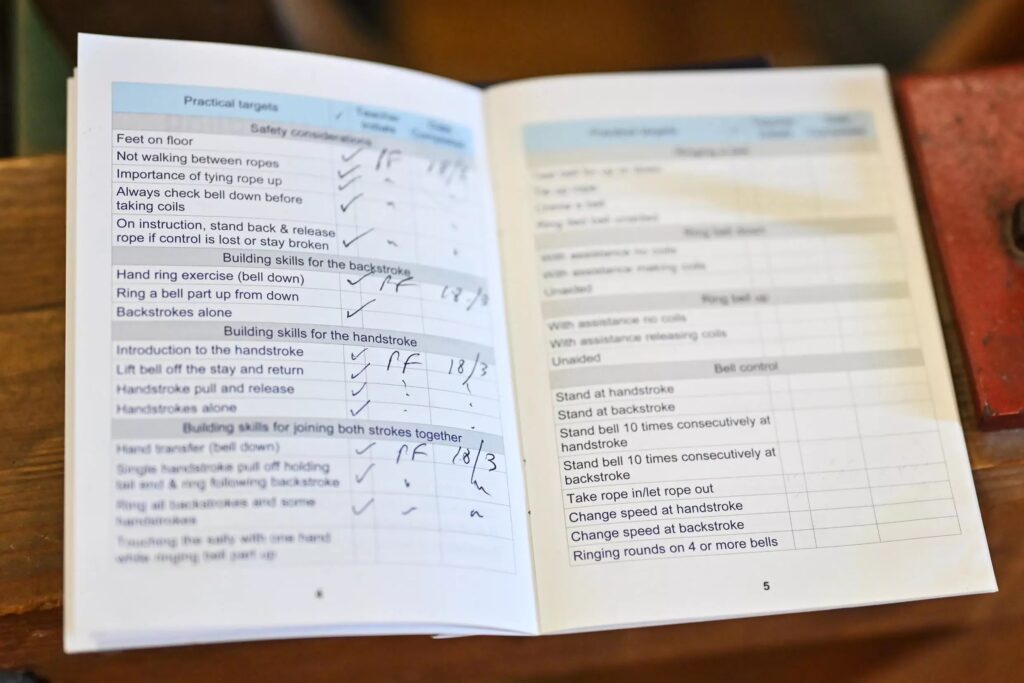
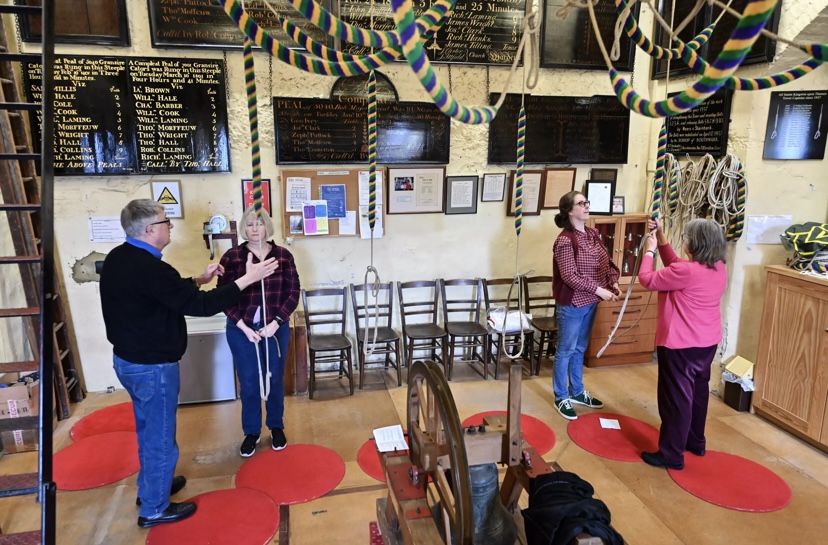

So-Shan, who does our Communications and social media, spoke to Kevin Duala on BBC Radio Surrey this morning about bellringing and the Ring for the King initiative.
Thank you for having us on the show. And if you fancy a go, do get in touch with us or your local tower.
Listen to the screengrab from BBC Sounds on Instagram.
Scroll to 1:23 to listen here: https://www.bbc.co.uk/sounds/play/p0f4fngn
The Surrey Association Quarter Peal Month will take place from 22 April to 28 May to encourage people to ring for the Coronation of the King.
The Surrey Association want to get as many first quarter pealers. If you are interested in ringing a quarter peal or have a promising ringer you would like to ring a first quarter peal, get in touch with the association if you need help getting a band together or organising a quarter/band.
The Peal Weekend will take place over the weekend of 29-30 April.
Judith and David from the Kingston band appear in the March 2023 issue of The Diocese of Southwark’s newspaper, The Bridge.
You can look at back issues here.

Article copied out below, in case you have any issues with PDFs or issuu.
On Sunday 13 February All Saints, Kingston was featured on ‘Love
Your Weekend’ with Alan Titchmarsh, exploring the traditional
sound of church bells, and the people who ring them on a Sunday.
As bell ringers across the country prepare to ‘Ring for the King’ to celebrate the coronation of His Majesty King Charles III on 6 May, there was a visit to All Saints, Kingston to discover more about the history behind bell ringing and meet The Revd Joe Moffatt, Pippa Joiner, Learning
and Engagement Officer, and the band of bell ringers. A segment of this was broadcast during the program.
Revd Joe Moffatt said: “This year is special because of the coronation of King Charles. It is something that we have a particular interest in because this is the site where seven Saxon Kings are known to have been crowned and Athelstan, one of those kings, was said to be the first king of all England and so this is where, we claim, England began.”
Pippa also shared a glimpse of history in talking about King Athelstan who was the first king to wear a crown and said “He had a special kind of coronation designed for him, which kind of formed the backbone of coronation services today.”
Change ringing – the rhythmic ringing of church bells in a coordinated sequence – is something that husband and wife, David and Judith, have been doing together since they met over 60 years ago and they have
both been part of the band of bell ringers at All Saints, Kingston for many years.
David, 90, said: “Well, the story for me started at the age of 18 when I went to university. I heard two of my fellow students talking about bell ringing. It sounded fascinating and I decided to learn. After several years, at the University of London Society of Change Ringers Annual Dinner, I met Judith.”
Judith, 83, said’ “I was about 15 and went to an all girls school. I came from an all girls family and I wanted to meet some boys. A request was put out for young people to come and learn bell ringing. I thought, ah, that might answer my question! I wasn’t part of a church, but it sounded fun. I first learned to handle a bell and then to ring methods. Then I went off to university and went to my first annual dinner and sat opposite me was this young man – David – and we had quite a lot of the same interests.”
Bell ringing requires a lot of skill and coordination. Judith describes bell ringing as “an art and a science, it’s physical and intellectual. You never stop learning: it requires coordination, listening, rhythm, and it’s very much about teamwork.” The band at All Saints practice once a week on Wednesdays and ring twice for services on Sundays. In the tower there is a peal of 12 bells, with the weight of the tenor bell at 900kg. The word ‘peal’ also refers to a length of continuous ringing which can last for about three hours non-stop and comprises upwards of 5,000 changes.
David likened bell ringing to riding a bicycle and said: “Once you can do it, you don’t understand quite why other people can’t.”
David and Judith now live in Cobham, but over the years they have rung and worshipped at churches in various parts of the country. For the last 30 years they have rung with the band at All Saints, Kingston.
Change ringing is an essentially English tradition, but it has spread to a number of places around the world and David has taken the opportunity to ring bells in America and South Africa. Bell ringing can be enjoyed by people of all ages and at All Saints there is a diverse band, with different levels of skill and experience in ringing and a group of people who have
formed lasting friendships.
In sharing a message to interested bell ringers, Judith said: “Find a tower near you, find out who the master is, make contact and just arrange a time to meet to see what it’s like”.
Watch ‘Love Your Weekend’ on ITVx where you can see All Saints, Kingston from 57 minutes into the program: https://bit.ly/3KyiR39.